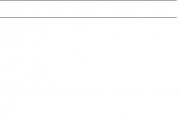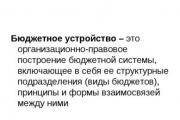Accounting info. Accounting info 1c disable control of negative balances
Any organization must monitor stock balances. And often a situation arises when the product is actually available, but it is not in the program. And then the accountant is forced to make a decision:
- allow it to be sold;
- postpone until it becomes clear why this situation arose.
The decision, as a rule, is made based on the policy that is followed in the organization in relation to the accounting of balances. Sometimes you can put the product aside and tell the buyer that it is not possible to sell it now. Sometimes this is impossible to do. For example, when the buyer sees this product or is already holding it in his hands.
You can, of course, simply generate a sales document and not post the document, but not all organizations allow this. Therefore, in the 1C 8.3 program (as in 8.2) it is possible to disable the control of negative balances.
If balance control is enabled, then when selling an item that is not in stock (or on the required account), the program will issue the following warning:
The “Quantity” column in line 1 of the “Products” list is filled in incorrectly.
The indicated quantity exceeds the balance. Remaining: 18; Missing: 111,093
Get 267 video lessons on 1C for free:
Disabling control of negative balances in 1C 8.3
To disable or enable balance control in 1C, you need to go to the “Main” menu, then in the “Settings” section select “ “.
In some versions of 1C Accounting, these settings are located in the “Administration - Document Posting Settings” menu.
In the “Accounting Parameters” you need to go to the 1C “Inventories” tab and check the “Allow write-off of inventories if there are no balances according to accounting data” checkbox:

Then all you have to do is click the “Save and Close” button. Now, when writing off, balances will not be controlled.
But such a method will inevitably lead to the appearance of negative balances in the warehouse (meaning, in the program). Let's look at how to deal with this.
Report “Control of negative balances”
In the simplest case, you just need to select a period and click the “Generate” button. And it was here that the first surprise awaited me.
I specifically simulated in the test program a situation where I sold more goods than I have in stock. Moreover, he made this sale in 2013. Logically, I still have the same product in the red now, in 2016. Therefore, I didn’t even touch the period, but immediately clicked “Generate”. It didn't work out for me. It turns out that the report can display information about negative balances only for the selected period.
This report helps to obtain summary or detailed information about negative balances on 41 accounts at any time. The result of the report is displayed with default detail (see Fig. 1)
Because Since the report is completely written using a data layout scheme, it will not be difficult for the user to change report sections from user mode (see Fig. 2)
The external report is intended for the configuration "1C: Enterprise Accounting 8, edition 3.0" and "edition 3.0 (KORP)", running on the platform version 8.2 in the “MANAGED APPLICATION” mode.
Free support period: 1 month.
Reasons to buy
Negative balances are always a headache for any accountant. Negative balances on 41 accounts doubly aggravate this situation. This report quickly and clearly shows all "redness" in 41 counts in a convenient and visual form. Moreover lAny negative balance on 41 accounts can be deciphered using the “Subconto Analysis” and “Account Card” reports. At the same time, by combining the use of these reports, it is possible to go straight down to the level of the record documents that caused the movement of goods. To do this, just click on the required number in the report and select the report for decoding.
According to numerous requests from users, a separate version of the report “Control of negative balances on inventory accounts” was created, which added the ability to control negative balances, not only for 41 accounts, but also other main accounts for the movement of inventory items:
Account 07 Equipment for installation
- Account 08.04 Acquisition of fixed assets
- Account 10 all, except 10.07 (Materials transferred for processing to third parties)
- Account 21 Semi-finished products of own production
- Account 41 all, except 41.12 (Goods in retail trade (in NTT at sales value))
- Account 42.01 Trade margins at automated retail outlets
- Account 43 Finished products
Also, remember that negative balances can arise not only in inventory accounts, but also in the customs declaration account. If you need to control this account too, we recommend that you familiarize yourself with the external report
Advantages
- Connection through the mechanism of external processing and reporting. This allows you to use the report without making any changes to the standard configuration. It is also possible to open a standard report via “File” -> “Open”.
- Ability to customize the report from user mode.
Money back guarantee
Infostart LLC guarantees you a 100% refund if the program does not correspond to the declared functionality from the description. The money can be returned in full if you request this within 14 days from the date the money is received in our account.
The program has been so proven to work that we can give such a guarantee with complete confidence. We want all our customers to be satisfied with their purchase.
Control over warehouse balances is a mandatory accounting procedure at any enterprise working with goods. Often you may encounter a situation where there is no product in the program, but it is actually in the warehouse. In such a situation, there are two options:
- Send it for sale;
- Leave it in the warehouse until the circumstances of this situation are clarified.
The choice depends on several factors, such as organizational policies or the specific situation. If the product is on the counter and the buyer is interested in it (holding it in his hands), it is not advisable to refuse the sale.
Some enterprises practice generating a sales document without posting it, but not all use this practice. In case of such situations, the 1C program in its latest versions offers the ability to disable control of negative balances.
When control is activated, the sale of goods that are not in stock according to the program will give the user a warning: “The “Quantity” column in line 1 of the “Products” list is filled in incorrectly. “The indicated quantity exceeds the balance. Remaining: 18. Missing 111,093.”
Disabling control of negative balances in 1C
The operation of turning on/off control of balances in 1C is carried out through the menu “Main” - “Settings” - “Accounting parameters” - “Inventories”. Here you need to check the box “Allow write-off of inventory if there is no inventory according to accounting data.”

After this, the action is confirmed with the “Record and close” button. In turn, such actions are guaranteed to become the basis for the formation of negative balances in accounting. They will need to be eliminated.
Report “Control of negative balances”
This report is generated through the menu “Warehouse” - “Reports”, where the document is presented. The user is required to determine the request interval and click on the “Generate” button. The absence of a specified period will not allow you to show negative balances, which is a feature of the system that requires mandatory completion of the “Period” column.
The finished report has the following appearance.

A standard set of filters is available for the report itself, including grouping, sorting and other data transformations in accordance with user requests and needs. Using the “Show Settings” button, you can manually include additional lines in the report.
There are two types of situations in which it is necessary to set up balance control.
First situation. Sometimes accountants have to face the problem of the impossibility of writing off materials or goods in the 1C 8.3 program due to their absence in accounting, although in fact they are available. And the accountant urgently needs to prepare documents for the shipment of materials or goods:
This situation is possible if the organization has just started accounting in 1C 8.3 or the data is not entered into the program in a timely manner.
The second situation is when an accountant writes off materials that are not available in the warehouse. And the accountant prepares shipping documents, which is not very good for the company’s reputation.
Setting up balance control
In the 1C 8.3 Accounting program there is a setting for controlling balances. And when creating a database, the default settings allow you to write off goods that, according to accounting data, are not available in the program.
Balances are controlled in the context of a specific organization and warehouse in all types of documents: sales, demand invoice, movements, etc., where accounts with the Warehouse analytics are involved.
Important! In order to control balances at the warehouse level, in 1C 8.3 it is necessary to install warehouse analytics in the accounts of goods or materials.
Thus:
- For the first situation, you need to check the box and enter all balances of materials into the database. And it is advisable to record the receipt of goods and materials in a timely manner after this.
- For the second situation, you need to uncheck the box to prohibit writing off missing goods (materials).
How to disable balance control in 1C 8.3
To remove the ban on posting documents with missing goods, you need to go to the settings of the 1C 8.3 program in the Administration section - then Document Posting Settings:

check the box Allowed to write off inventories if there are no balances according to accounting data:

Control of balances in the context of warehouses
To prevent negative balances for warehouses, we set the analytics By warehouses. You can enable analytics for warehouses in the accounting settings: section Administration - then Accounting parameters. Choose Setting up a chart of accounts and in inventory accounting click on By item and warehouse (by quantity):

Set the flag in the new window By warehouses (storage locations). This checkbox will affect the control of balances in the context of warehouses:
- If the checkbox is unchecked, balance control is carried out by organization;
- If the checkbox is checked, in the context of an organization and a specific warehouse:

Control of negative balances in 1C 8.3
If it is not possible to uncheck the box or there are reasons to keep records with negative balances, 1C 8.3 Accounting implements a report that allows you to control negative balances.
Report Control of negative balances in 1C 8.3 it is located in the Warehouses section - then Control of negative balances:

A report can be generated for a certain period with details on documents, warehouses, items and other accounting objects. And also display data for a specific warehouse or item using selection:

Important! The Negative Balance Control report shows negative balances only for the specified period. If there were documents written off before the start of the report, then negative balances for them will not be included in the report.
To change report settings, you must use the Show settings command. By moving through the settings tabs Grouping, Selection, Additional fields, you can give the report the desired appearance:

On the website you can view the configuration of 1C Accounting 8.3.
More details about setting up the 1C 8.2 (8.3) program Prohibition of writing off inventory if there are no balances How it affects financial results, see the following video:
Please rate this article:
In my video tutorials, I often talk about the fact that the 1C database must be prepared for period closure and reporting. And one of the important points of such preparation is the control of negative balances of goods, materials and finished products. What reports should you use to check the status of inventory accounts in 1C: Accounting? Let's look at some of them.
1. Report “Account balance sheet”
Many accountants are accustomed to working with account balance sheets. This report can indeed be used to control inventory balances, you just need to make sure that the settings are set to display quantitative indicators.Click the “Show settings” button and go to the “Indicators” tab.
Then we carefully review the report and analyze the detected errors

The balance sheet is convenient because it allows you to evaluate not only the presence of negative quantitative balances, but also to detect other problematic situations:
- quantitative balance of inventory items without amount;
- total balance without quantity;
- negative balance.
However, if a large number of item items are involved in accounting, then such a check can be quite labor-intensive. In addition, SALT will have to be generated separately for each accounting account (10, 41, 43), which also somewhat complicates the work process.
2. Report "Control of negative balances"
The 1C: Enterprise Accounting 8 edition 3.0 configuration provides a report that is ideal for monitoring negative quantitative balances of inventory items. The report is located on the “Warehouse” tab.
We indicate the period, organization and generate a report.

The report includes only those item items for which a negative quantitative balance was detected. The big advantage is that data on all inventory accounts is analyzed. In my opinion, it is more convenient to work with the report than with OSV.
But there is also a minus - the report allows you to monitor only negative quantitative balances, leaving behind the scenes other problems that SALT allows you to detect.
3. Report “Analysis of subconto”
I have talked about this report more than once. Subconto analysis is one of my favorite reports, which allows you not only to detect errors, but also, in many situations, to understand their causes.Go to the “Reports” - “Subconto Analysis” section.

Select the “Nomenclature” subconto and check that the display of quantitative indicators is enabled in the report settings.

Subconto analysis is good because it allows you to obtain information about the movement of inventory items across all accounting accounts. For example, to track situations where a product arrived at one accounting account, but was sold from another.

However, with a large number of items, it can be difficult to analyze the data.
I talked more about working with this report in the video tutorial How to work with the “Subconto Analysis” report in 1C - VIDEO.
Thus, each of the reviewed reports has its pros and cons. In my work, I would recommend combining them:
- find gross errors using the “Control of Negative Balances” report;
- then view the SALT for all inventory accounts;
- to identify the reasons for an incorrect balance, use the “Subconto Analysis” report.
I also discussed interesting examples related to finding and correcting errors when accounting for inventory items in two useful videos:














